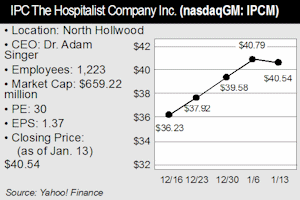For IPC The Hospitalist Company, 2010 was one of the busiest years in the North Hollywood firm’s history with a total of 15 acquisitions. Rising revenues and stock prices have accompanied the activity with analysts expecting more of the same for the company in the new year. The acquisitions of hospitalist and other facility-based group practices have added 700,000 annualized “patient encounters” to IPC’s portfolio. “IPC probably acquired 550,000 patient encounters in the fourth quarter,” said Ryan Daniels, a health care analyst for William Blair & Company, LLC. “The company generates revenues on an encounter-per-day basis,” Daniels said, adding that the 2010 acquired patient encounters will probably add about $60 million to $65 million in revenues. These are the most acquisitions the company has ever made, said Dr. Adam Singer, the company’s CEO. In comparison, the company had added 287,000 annualized patient encounters in 2009 through eight acquisitions. IPC is in the business of providing physicians (so-called hospitalists) who manage patient care in coordination with primary care physicians and specialists. Singer said that while he does not project information about future acquisitions, he definitely expects a high volume of purchases in the future. “We clearly have a very aggressive pipeline of deals, and our pipeline is extremely full and robust,” he said. In the last quarter we did a lot of deals and every one of those deals was replaced by a deal in the pipeline. So, we continue to have lots of opportunities.” Market expansion Singer estimated that acquisitions probably account for about half of IPC’s growth, with the other half stemming from new hires. For acquisitions, the idea is to expand to new markets and then later build on those through “same-store” growth, Singer said. The company, which has practices in 22 states, was able to expand to two new markets in Kansas City and Austin through acquisitions this year. Singer said three main factors are considered before an acquisition is made: The company considers whether the physicians involved are aligned with IPC’s focus on quality of care, whether the practice and market have growth potential and whether the deal would be financially beneficial to the physicians involved. Once the deal is done, the added hospitalists receive training to align with the company’s technology and protocols. “Buying something is easy, and there’s a price for everything,” Singer said. “But actually successfully buying something is a whole other ball of wax. You really need to have a team of people in place that know how to do that, to operationally integrate rapidly the acquisition and have some way of starting to build a culture between you and that acquired group.” Through the company’s acquisitions, IPC has mostly remained in line with its two focus areas – acute and post-acute care, or care in hospitals and care at facilities such as nursing homes, long-term acute care facilities and assisted living facilities. The focus into the post-acute setting is designed to provide a better coordinated care model. “In a world of accountable care organizations you’re going to need to be accountable for that care throughout an episode of an illness,” Singer said. “(Patients) can get taken care of in the hospital, and we have established hand-offs to our own providers in the nursing homes.” According to Dawn Brock, senior health analyst at Kaufman Bros., IPC is making a smart move. “I think they have first-mover advantage into the post-acute market, which is in my mind a completely untapped market for the hospitalist specialty,” she said. “What they’re doing can be viewed as visionary and it’s purely by nature of the patients that they cover that they would be able to create this type of structure.” Financial growth For the first nine months of 2010, IPC reported a 17 percent increase in revenue and a 30 percent increase in net income compared to the same period in 2009. While revenue and earnings figures have not yet been released for the entire year of 2010, Singer said he is definitely expecting to see growth over 2009 figures. Brock is projecting the company’s 2010 revenue will show growth of 17 percent to about $362.3 million, up from revenue of $310.5 million in 2009. As of Jan. 12, the company’s stock price was up 19 percent over the last year at the closing price of $40.88. In June, the company’s stock price took a 21-percent dip after the Department of Justice issued a civil investigative demand on the company related to IPC’s Medicare and Medicaid participation. However, the stock price recovered and continued to rise after assurances by management there was no wrongdoing. While Brock identifies the investigation as a possible investment risk for the company, she said it does not appear that it is impeding the company’s performance. She said much of the company’s success has come from good business and clinical leadership, as well as a smart growth strategy. “They have made large and small acquisitions,” she said. “They strike a very nice balance between expanding in existing markets and breaking ground in new markets. I think that is one of the keys for investors and one of the reasons that the stock has done so well in recent months.”
